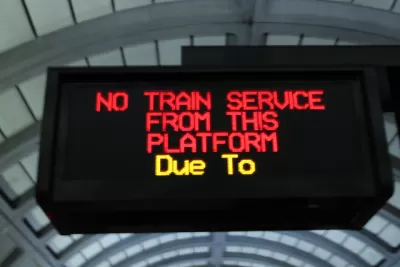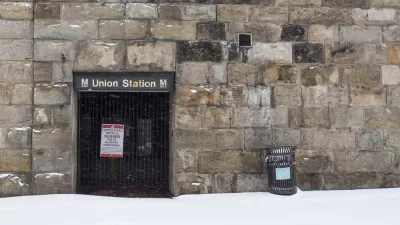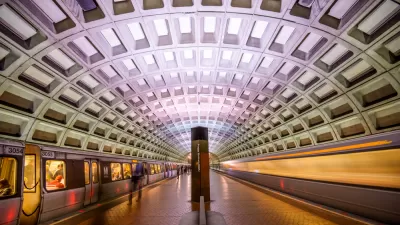The word "shocking" above could also have been "depressing," and the word "storm" could have also been "rant." Or it could have been "honest" and "victory." When it comes to transit, everyone sees what they want to see.

March 16, 2016: a day that will live in transit infamy.
That might be putting it too mildly. If you'll excuse my use of the common tongue of the modern transit user: March 16, 2016 was the day the transit shit hit the fan.
The origins of Snafu Day, which is what I'm calling it, began on March 15, when D.C. Metro General Manager and CEO Paul J. Wiedefeld made a surprise announcement that the Washington, D.C. region's Metrorail system would be shut down for an emergency safety inspection.
The four stages of transit grief that emerged in response to this announcement went something like this: 1) WTF? 2) How am I going to get to work? 3) This sucks, and 4) How did this happen?
On that latter question, a few media outlets turned their attention away from the critical question of how the Beltway elite would get to work to finally score some points for the plebes: that is, transit is underfunded and only likely to get worse as backlogs and deferred maintenance ravage aging systems. These are excellent points, and the need to raise awareness about how the country funds (or doesn't fund) infrastructure will remain a pressing issue, long after the initial shock over the Metrorail shutdown subsides. Maybe it will help that this particular crisis impacted the very elites that are at least partly responsible for how transit is funded. Maybe it will help, but I doubt it.
The transit gods, however, would not allow Snafu Day an East Coast bias, and the BART system in the San Francisco Bay Area also experienced its own, system-crippling delays. BART spent Snafu Day, and the day after, searching for an electrical problem that had damaged 50 cars between the North Concord and Pittsburg stations, after a similar problem had damaged 80 cars in the Transbay Tube earlier in March.
Amidst the frustrations of a delayed evening commute, the Twitter peanut gallery was not happy. In response, @SFBART did not turn the other Twitter cheek. Rather, it offered a string of seemingly uncensored responses that reads like a trip to the confession booth.
The messages were contrite enough that Los Angeles Times transportation reporter Laura Nelson offered an "emergency hug," the @metrolosangeles Twitter account offered a fist bump of solidarity, and Vox writer Libby Nelson lauded the honesty of @SFBART in explaining the delays (which was then echoed by Vox founder Ezra Klein and Human Transit blogger and consultant Jarrett Walker).
Since then, Taylor Huckaby, one of the real people behind the Snafu Day Twitter Storm, as I'm calling it, has been interviewed by the San Francisco Chronicle and many more people have chimed into the discussion under the hashtag #ThisIsOurReality.
Maybe the Snafu Day Twitter Storm was refreshingly frank, raw, and unfiltered, and, maybe @SFBART was mostly arguing for the same kind of transit future I think the world needs.
But it's a slippery slope from honest and refreshing to evasive and equivocating—kind of like a gambler bemoaning his or her losses because the house isn't dealing good cards.
If we congratulate BART on its honesty, then we're guilty of seeing the transit reality we want to see, rather than the one we should be working toward. That is, if we believe that the Snafu Day Twitter Storm is a novel form of honesty, out of some faith that these words will somehow succeed where all the words before have failed, then we readily accept less than the transit system we need.
If no one has told you this yet, let me be the first: uncritical transit boosterism is almost as bad as driving your car to work everyday.
Honesty would be for BART to supply data on the productivity of the employees working for BART, and pink slips for underperforming employees. Honesty would be to admit that the status quo of BART's business operations contributes to high fares and low frequencies. Honesty would be to admit that mistakes in planning and operations have been made, repeatedly, throughout the system's history. Tell us how many BART employees drove to work today, and prohibit promotions for anyone who drives to work more than 1.5 days a week, on average. That kind of conversation might earn the benefit of the doubt about the honesty of any rants in the future, and it might earn BART a seat at the table when and where transit gets fixed.
Until then, however, there is no table, and there are no fixes. Saying you're trying isn't good enough.
It was a bit of a stroke of luck that led me to the Snafu Day Twitter Storm as it happened. I encountered it with my head buried in my phone, frantically refreshing, without much luck, the Go Metro app in Los Angeles. First the app's arrival time function had crashed, and then the bus I was tracking on the app had disappeared for several miles along the route. This mess had all taken place in the large window of time made available by a 50-minute headway on the only north-south route in my dense urban neighborhood, located in the core of the second largest city in the country.
Make all the excuses you want: transit can be its own worst enemy. Transit produces devastating levels of frustration, at times, even for those passionately committed to its improvement, as @SFBART admitted last night:
I enjoy transit a great deal when it's working, which is the majority of the time. When transit fails, however, it doesn't usually feel like the result of an uncontrollable legacy of decades of poor planning, engineering, and political decisions. The failure is specific and personal for the user, so making that failure less personal by pointing out the tremendous political challenges of running transit seems, you know, disingenuous. I say that as a choice transit user, for which a late bus or a rail system shutdown is not a matter of life and death. D.C. Metro, @SFBART, and @metrolosangeles can fist bump all they want about how hard it is to keep the trains running on time. It's always going to be hard for them. Frankly, it's not about them.
There are places in this world where transit works. Buses and trains run frequently, with fares and travel times that offer a competitive advantage over the expenses, negative externalities, and sordid behavior of automobile traffic. There are also times and places in the United States where transit functions like the utopian dream so many of its boosters want it to be—providing access to jobs and culture while reducing environmental impacts and public health risks.
Give the real people behind the Snafu Day Twitter Storm (@AliciaTrost and @IWriteRealGood) a lot of credit for starting a conversation about the relative merits of transit subsidies and the other complex problems of transit. Most people in this country are much more comfortable discussing the relative merits of Hillary Clinton, Bernie Sanders, or Donald Trump. If only people devoted as much time to considering the consequences of their transportation decisions as they do exaggerating the consequences of their opinion on the next President of the United States. We only get a few chances to vote for the future President of the United States, and once a president is in office we can't control much of what they do on a day-to-day basis. Meanwhile we vote for the kind of world we want to live in, in a very tangible way, every time we choose between our cars, our bikes, our feet, or our transit system.
We need to make it harder for people to equivocate the consequences of their choices, just as we should stop accepting boosterism from politicians and planners. If we manage that, we should expect high frequency transit trips in all modes, transit routes running in exclusive right of ways, and an end to subsidies for automobile travel.
Until then, all we have are excuses.

Alabama: Trump Terminates Settlements for Black Communities Harmed By Raw Sewage
Trump deemed the landmark civil rights agreement “illegal DEI and environmental justice policy.”

Study: Maui’s Plan to Convert Vacation Rentals to Long-Term Housing Could Cause Nearly $1 Billion Economic Loss
The plan would reduce visitor accommodation by 25% resulting in 1,900 jobs lost.

Planetizen Federal Action Tracker
A weekly monitor of how Trump’s orders and actions are impacting planners and planning in America.

Grand Rapids Mayor Proposes Garage Conversion Plan
The mayor says allowing homeowners to convert garages to dwelling units could alleviate the city’s housing shortage.

Baltimore Ordered to Improve Sidewalk Accessibility
The city is one of many to face lawsuits for failing to comply with the Americans with Disabilities Act.

This Toronto Suburb Has More Bus Riders Than Columbus, Ohio
Brampton, Ontario used gradual improvements in service to prove that if you build it, they will ride.
Urban Design for Planners 1: Software Tools
This six-course series explores essential urban design concepts using open source software and equips planners with the tools they need to participate fully in the urban design process.
Planning for Universal Design
Learn the tools for implementing Universal Design in planning regulations.
Smith Gee Studio
Alamo Area Metropolitan Planning Organization
City of Santa Clarita
Institute for Housing and Urban Development Studies (IHS)
City of Grandview
Harvard GSD Executive Education
Toledo-Lucas County Plan Commissions
Salt Lake City
NYU Wagner Graduate School of Public Service



































